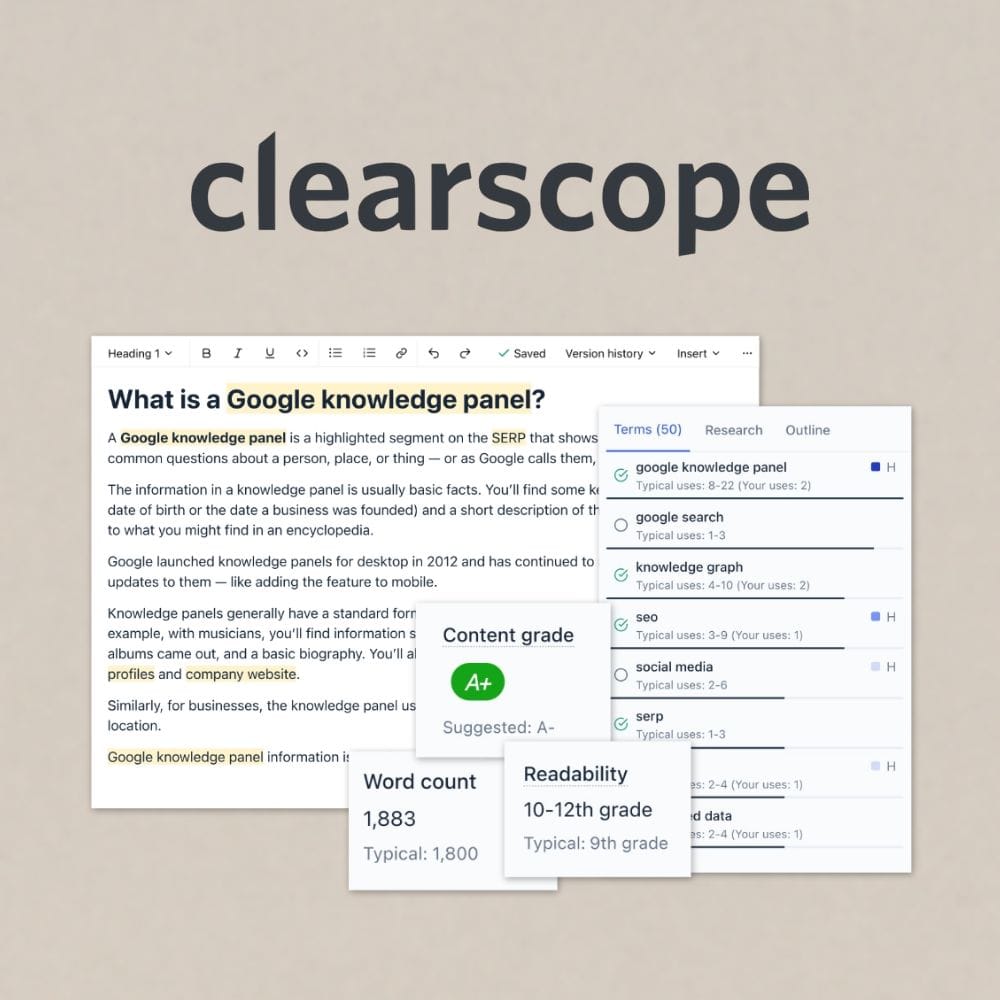Content optimization has come a long way from the days of stuffing random keywords into posts and hoping the SEO gods would smile upon you.
Today, you have tools like Clearscope that analyze top-ranking pages and show you which keywords and topics to include in your own content.
I've been using Clearscope for several months to optimize my website and client content. And I've seen some pretty decent improvements in search rankings.
Clearscope is offering a discount to the readers on my blog after I reviewed their tool. You can save on both their Essential and Business plan. It's all on this website. Go to their offer.
But is Clearscope the ultimate content optimization tool? Does it justify spending $129+ per month when competitors like Frase start at $45?
In this hands-on review of Clearscope, I'll show you exactly what you get for your money, how it stacks up against competitors, and whether it's worth the investment.
What is Clearscope?
Clearscope is a content optimization platform that analyzes top-ranking pages and shows you how to create better content for search engines. Founded in 2016 by Bernard Huang and Kevin Su, the platform uses natural language processing to study what makes content successful and provides recommendations for improving your writing.
What does Clearscope do?
Clearscope handles key content optimization tasks, including:
- Creating detailed content reports for any target keyword
- Providing real-time content grading and feedback
- Integrating with Google Docs for seamless workflow
- Tracking existing content performance over time
Unlike comprehensive SEO tools that handle everything from keyword research to technical audits, Clearscope focuses specifically on content optimization. The platform integrates well with Google Docs and support unlimited users without the complexity of broader SEO suites.
My Honest Experience With Clearscope
I've now used Clearscope for a few months and I've replaced a series of SEO tools with it. It has helped me grow SEO traffic accross my own sites, helped some friends and in general made it easier to rank in both Google and in LLMs.
I'll share what it's like to use Clearscope and whether it delivers on its promises.
First, I'll walk you through the content optimization process. Then, I'll cover the Google Docs integration and the AI features and see how it compares to other tools.
Setting up content optimization
My first project was a blog post about "buying coffee beans." I wanted to see if Clearscope could actually help me write better content.
I signed into the app and navigated to the Create Report section. This is where you enter your target keyword to generate optimization data.

I entered my target keyword in the search query field and kept the default location set to United States.
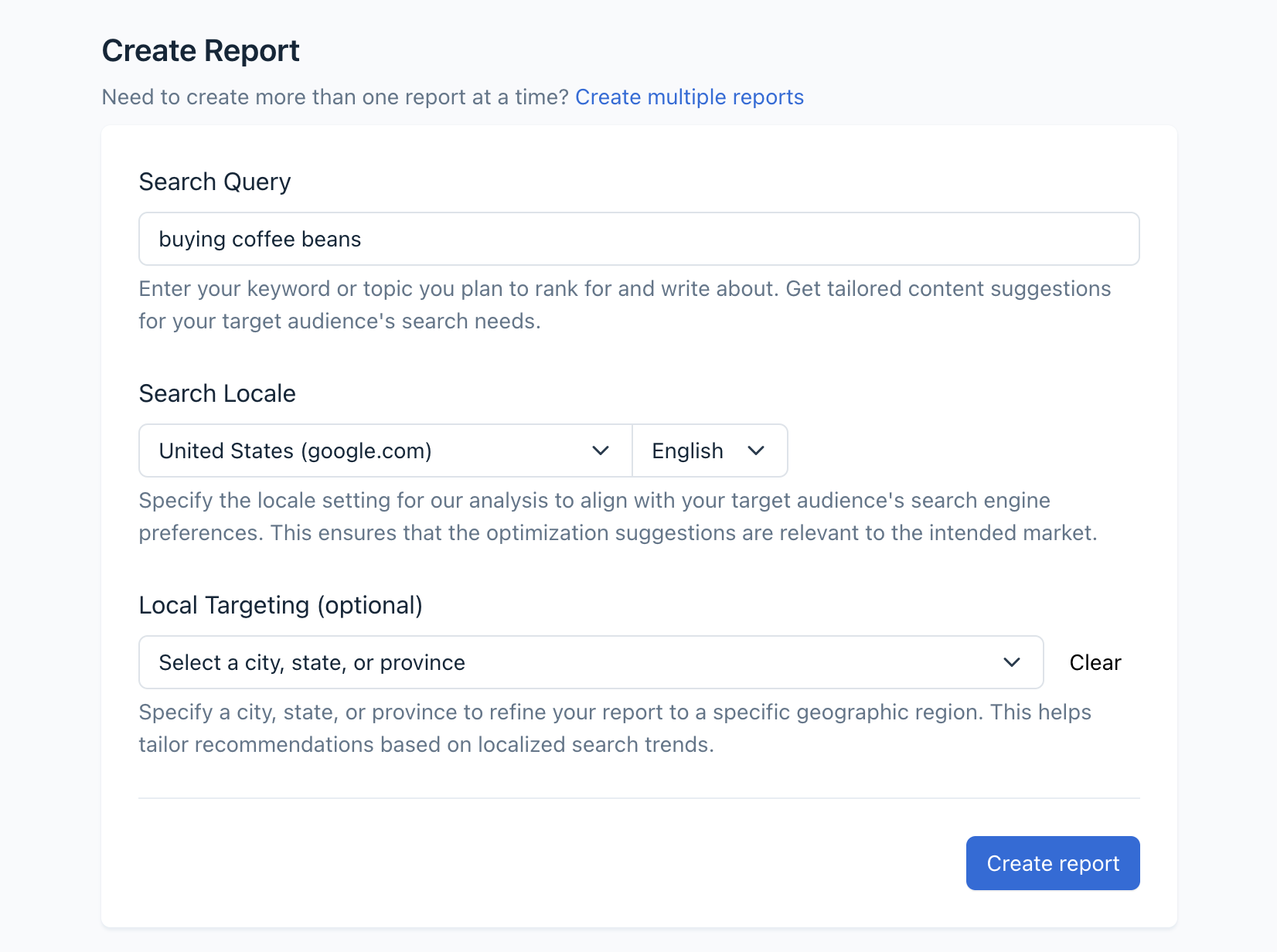
Then I clicked the Create Report button at the bottom and waited for Clearscope to process the data. It took about 5 minutes to complete.
Once finished, Clearscope showed me three options: use their Draft with AI feature, optimize existing content by entering a URL, or start from a blank draft. Since I wanted to test the manual optimization process first, I clicked 'start from a blank draft.'
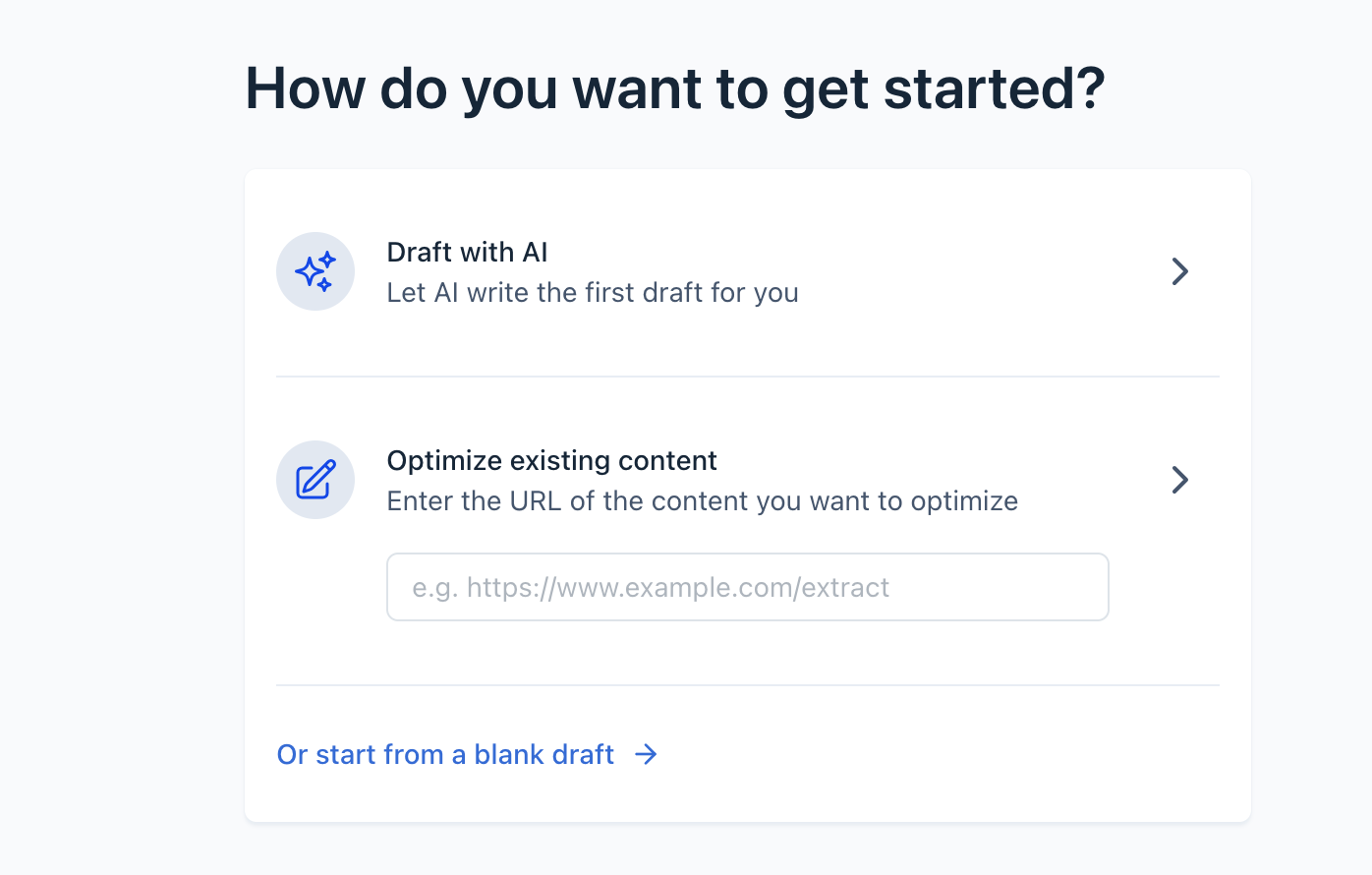
This took me to Clearscope's editor interface. On the left, I could see my content grade, word count, and readability metrics. The right sidebar showed a long list of related keywords I should include, like 'coffee beans,' 'roasted coffee,' 'arabica,' and 'coffee roasting.'
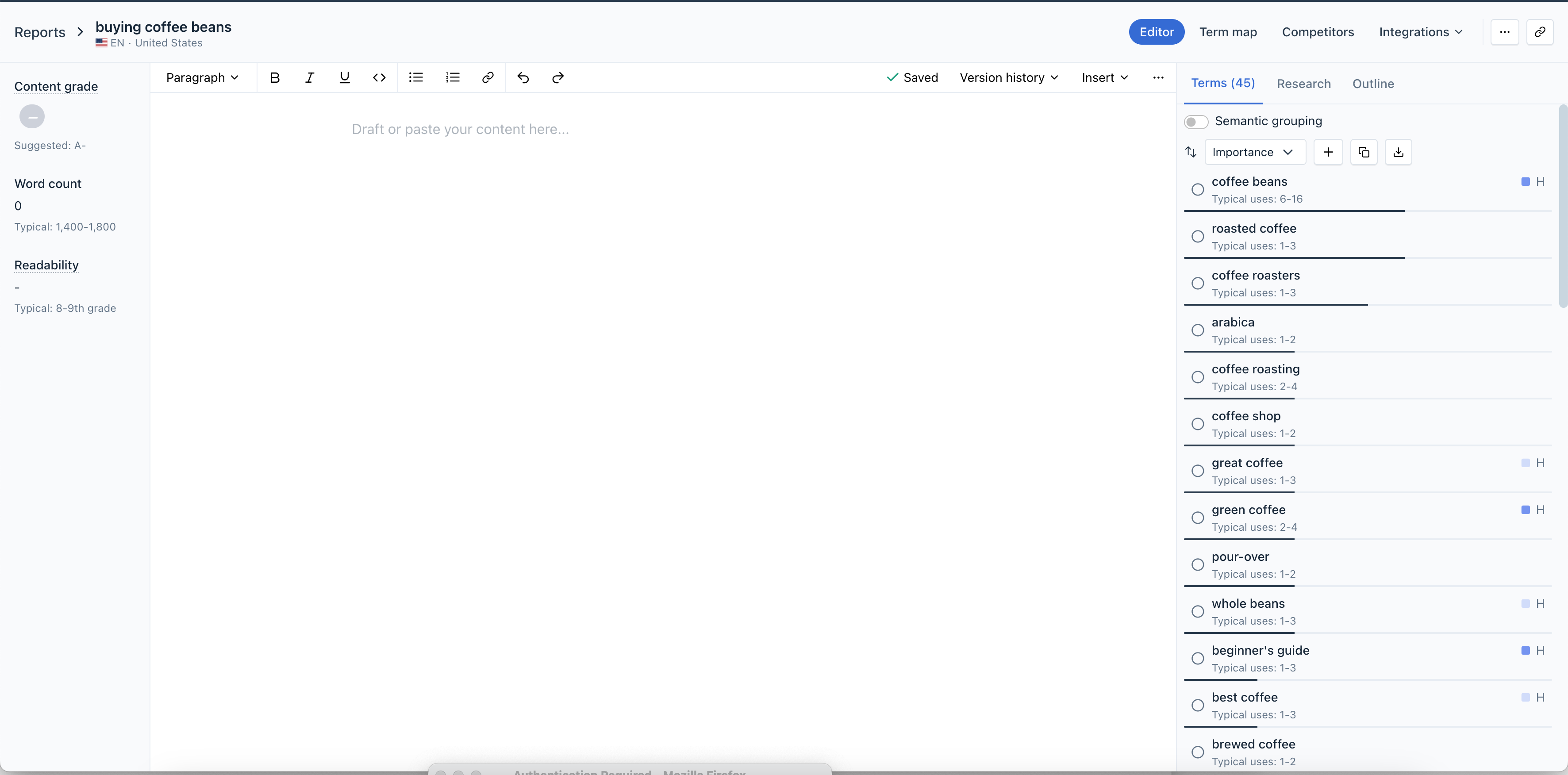
I liked how each keyword showed the typical usage numbers. 'Coffee beans' appeared 6 to 16 times in top-ranking articles. 'Arabica' only showed up 1 to 2 times. This gave me a clear sense of which terms were most important to include and how often to use them.
Keyword optimization and placement
As I started typing, something cool happened. Clearscope began checking off keywords on the right sidebar as I used them. When I mentioned "specialty coffee" in my paragraph, it got a green checkmark.
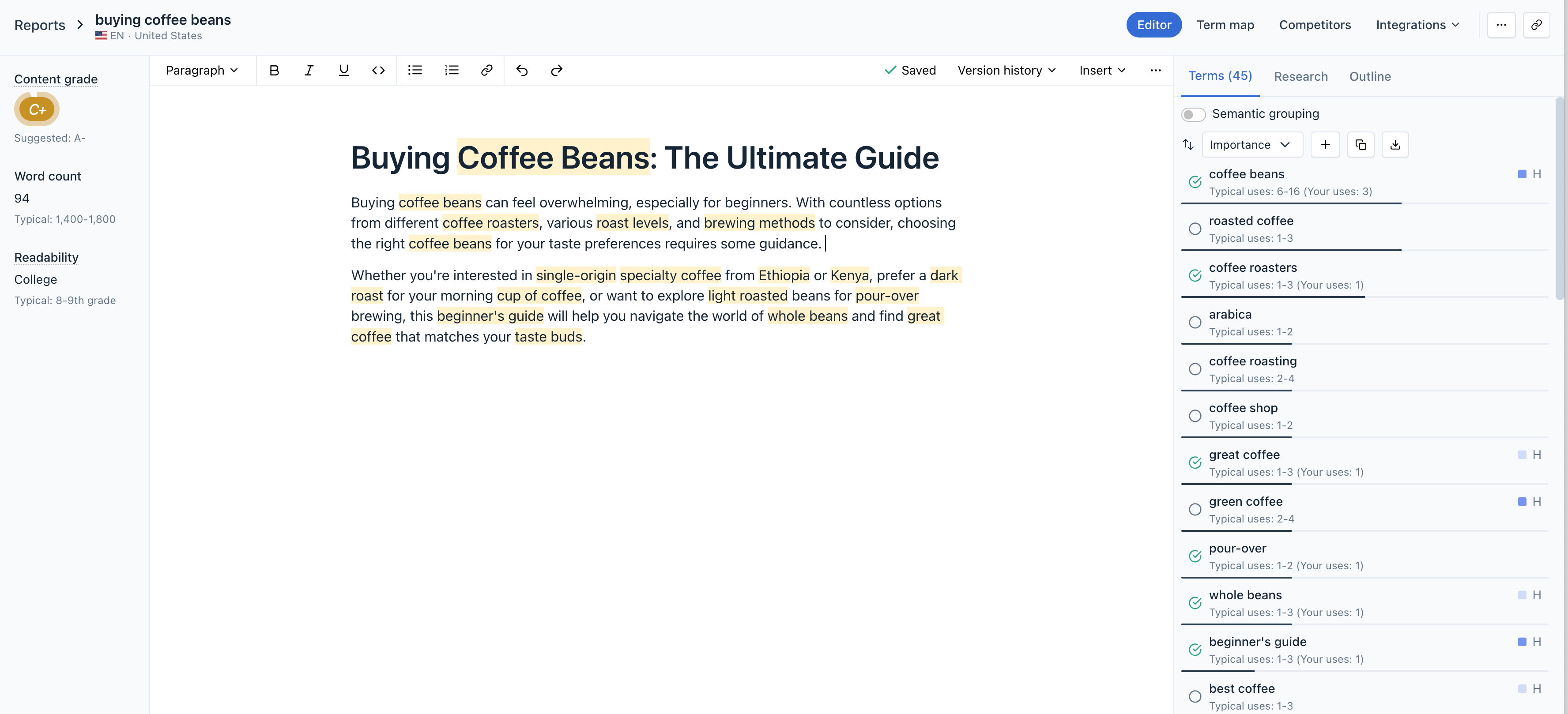
I hovered over one of the keywords to see what would happen. A popup showed me details like how important that term was and whether competitors typically used it in headings. For "specialty coffee," it had an importance score of 2 out of 10, which meant it wasn't super critical to include.
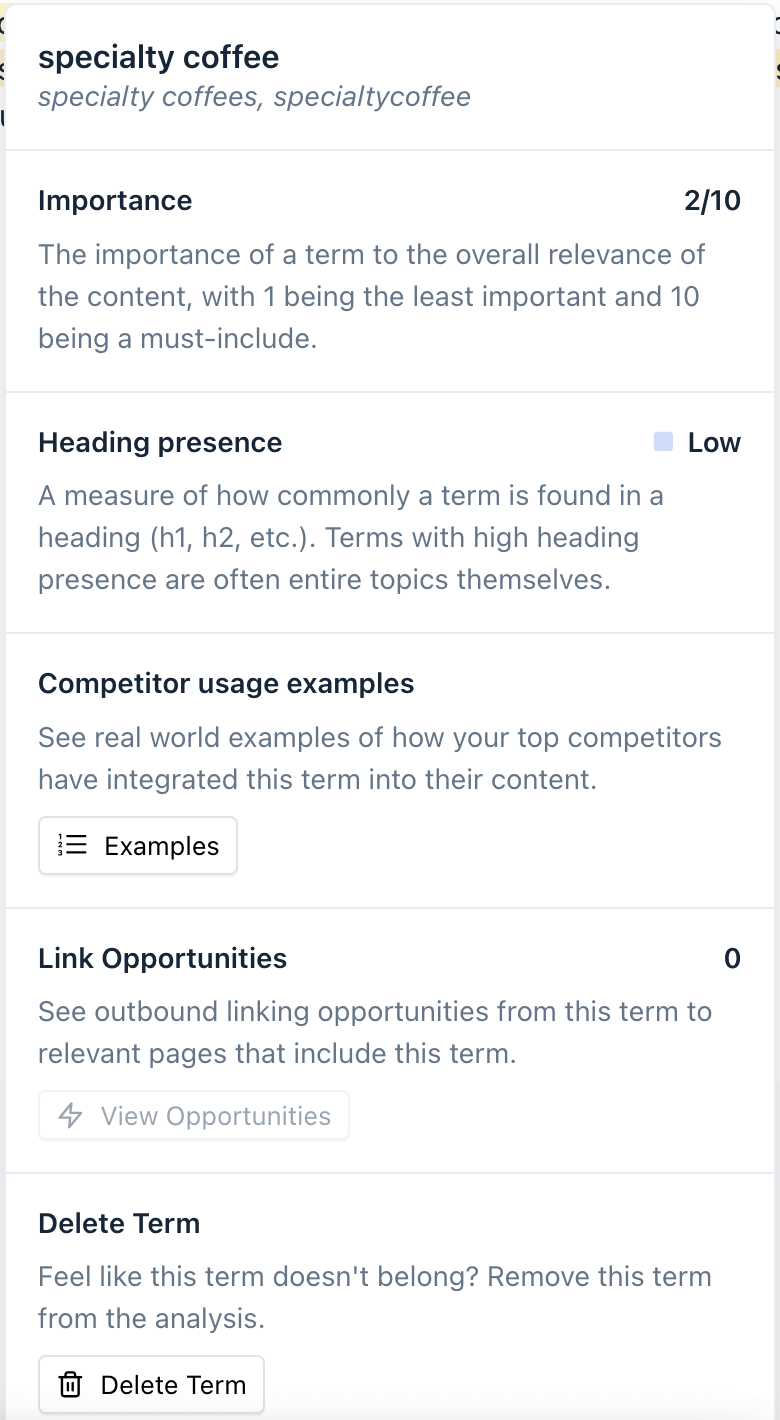
There was also a toggle for "Semantic grouping" at the top. When I turned it on, the keyword list reorganized into color-coded clusters. All the country names like Ethiopia, Kenya, and Rwanda got grouped together with brown bars. Flavor-related terms had different colors.
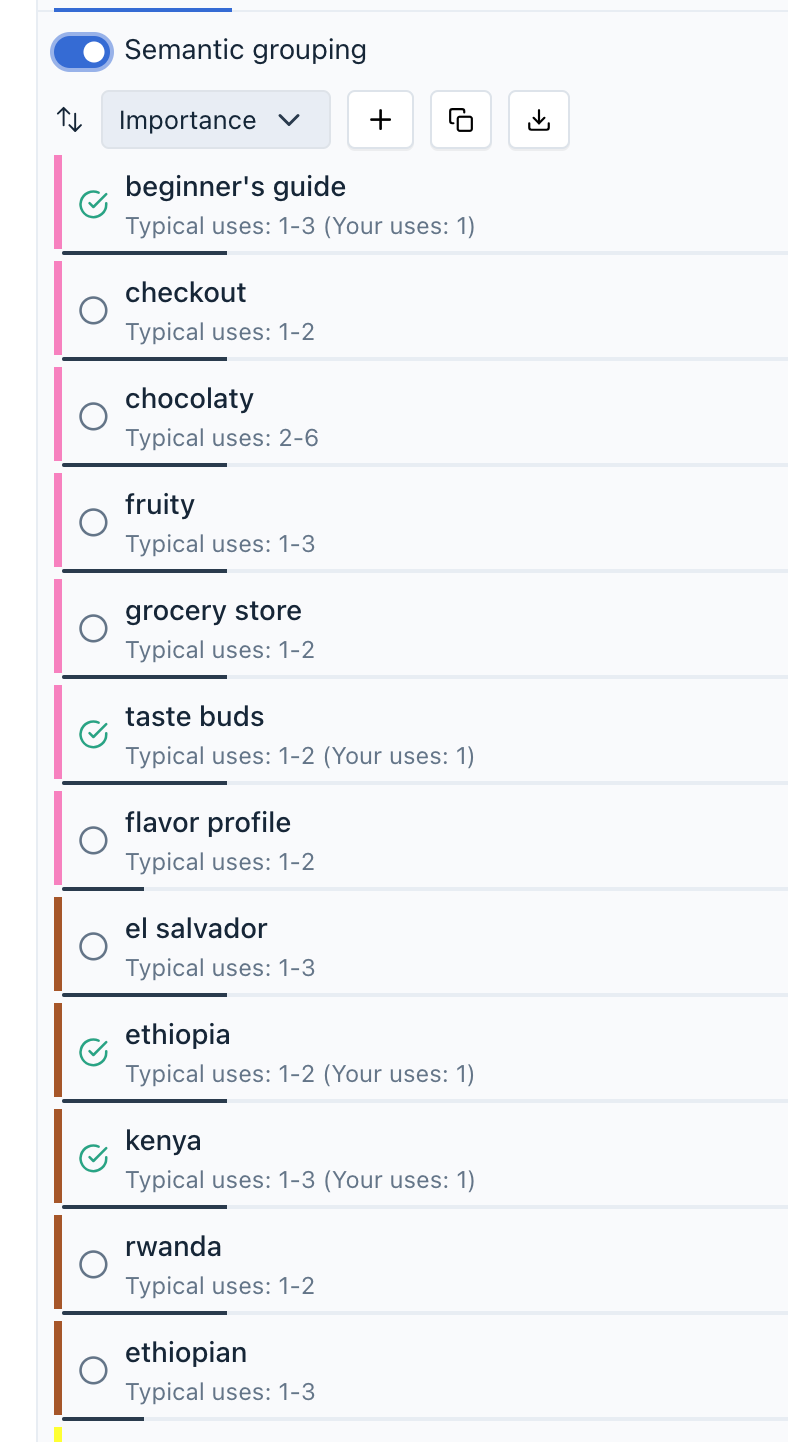
This made way more sense than just having a random list of keywords. I could see which terms belonged together and focus on one topic at a time instead of trying to cram in every single keyword.
Most keyword tools just dump a list on you and leave you to figure out the rest. Clearscope actually shows you how the keywords relate to each other, which makes writing feel less like keyword stuffing and more like covering topics naturally.
Research and questions
While I was looking at the keyword list, I noticed there were other tabs at the top. I clicked on Research to see what else Clearscope could show me.
This tab had a list of questions people ask about buying coffee beans. Things like "How do you know what coffee beans to buy?" and "What are the best coffee beans to buy?"
Some questions were specific, such as "What is the 80/20 rule for coffee?" and "How much ground coffee do you get from 1 kg of beans?" I hadn't planned on covering these topics initially.
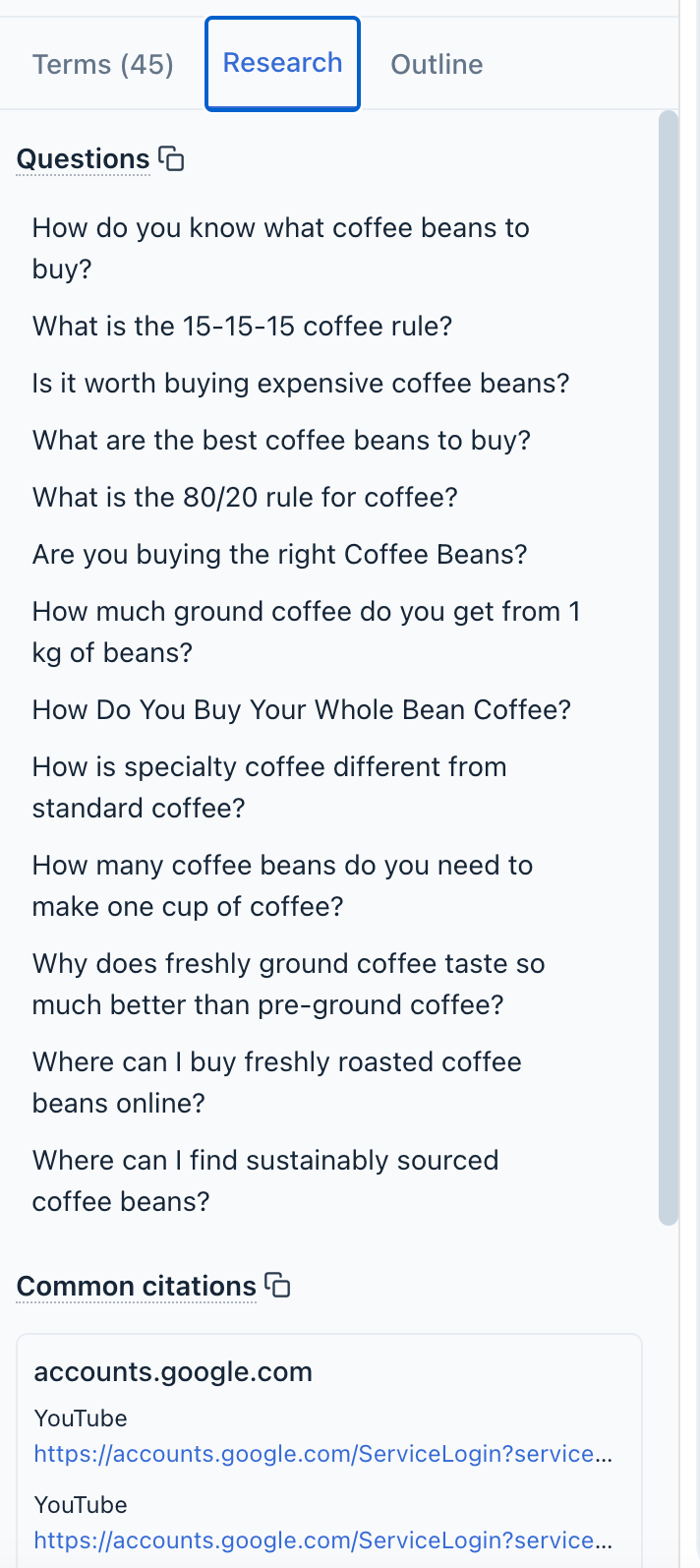
The tab also showed citation sources and external resources like Quora, Wikipedia, and Reddit that competitors reference.
Having all this info gave me a better sense of what to include in my article.
Competitor analysis
To get a sense of what I was competing against, Clearscope showed me typical benchmarks for articles targeting similar keywords. Most pieces about buying coffee beans ran 1,400 to 1,800 words. This gave me a target length. I'd need to write around that much or more to have a shot at ranking well.
I also noticed there were additional tabs at the top besides the main editor. I clicked on Term Map to see what it showed. This opened a visual chart with competitor websites positioned across the screen. Green blocks indicated which sites used specific keywords most frequently.
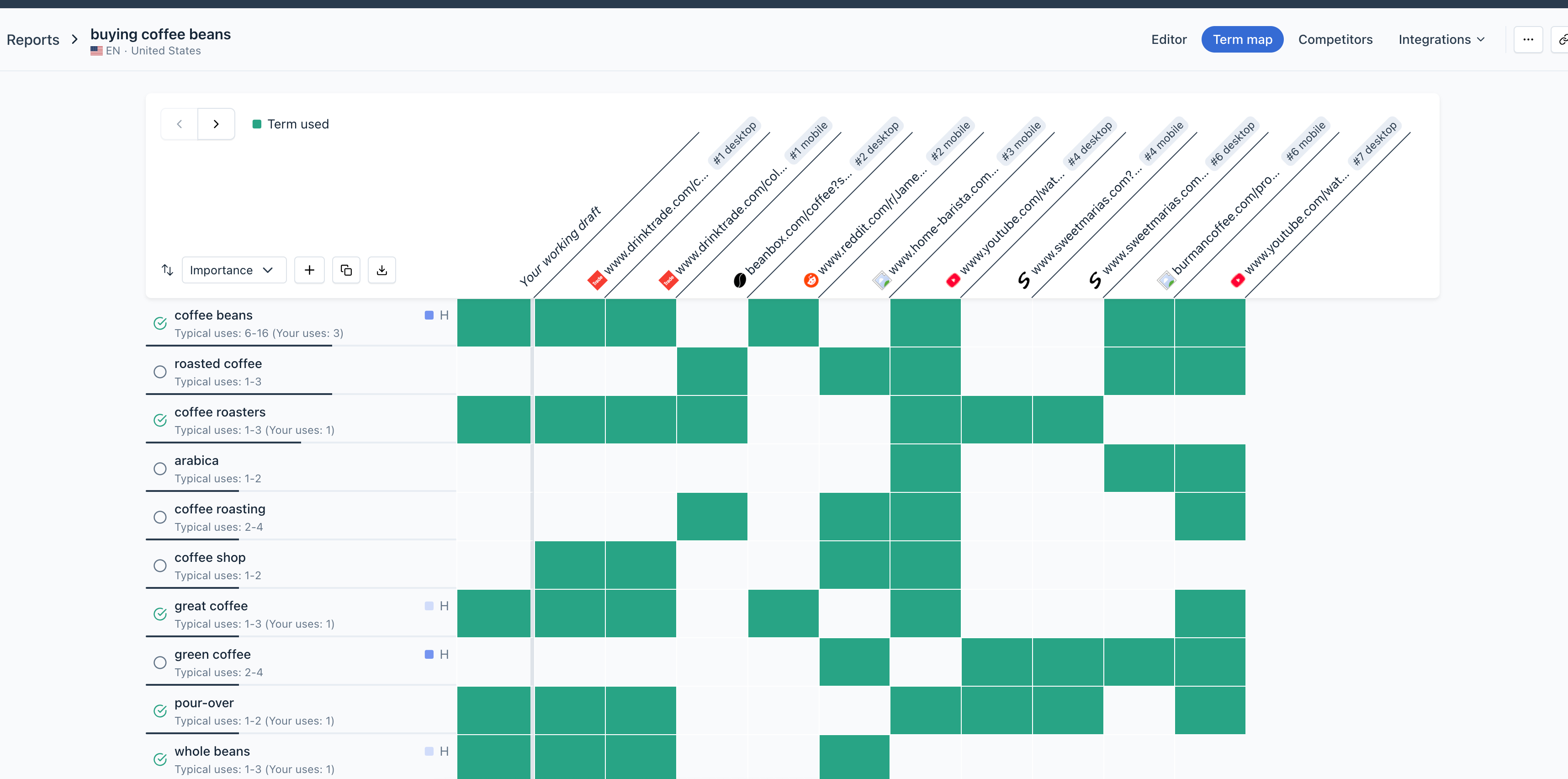
The Competitors tab was more informative. It listed the actual top ranking articles with their titles, word counts, and content grades. The first result was "Specialty Coffee | Buy Coffee Online" with 1,310 words and an A grade. A YouTube video had 1,409 words and earned a B+ grade.
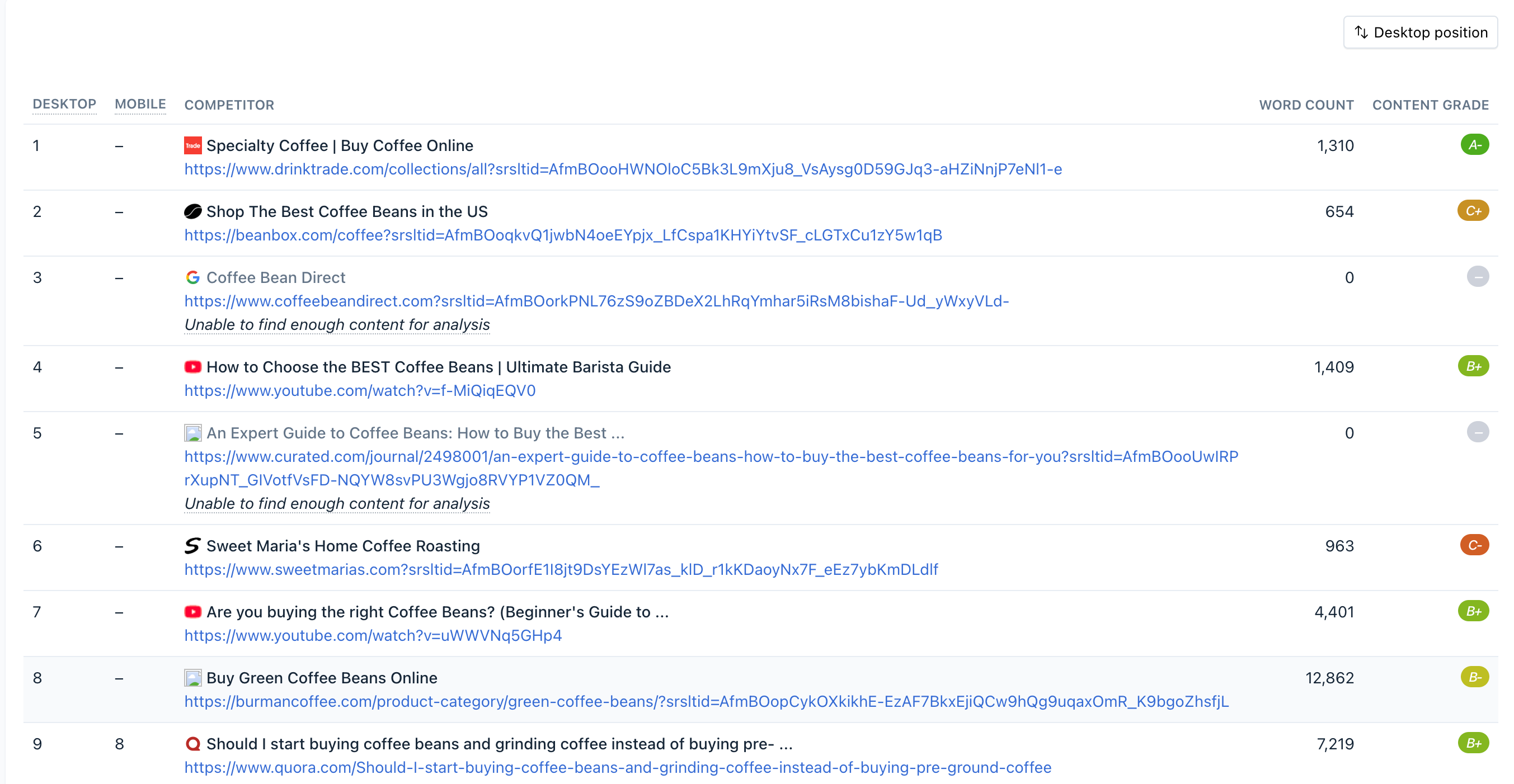
One article about green coffee beans clocked in at over 12,000 words. Someone really went all out on that topic.
This competitor data saved me from having to manually research each competing page. I could see what formats and lengths were working without the tedious task of checking every result myself. This gave me a game plan for my own article.
The grading system
As I typed content in the editor, I noticed the content grade on the left sidebar started changing.
Since top competitors were getting A- grades, I had to aim for at least that level to compete.
As I added more content and used the recommended keywords, my grade improved from C+ to higher levels.
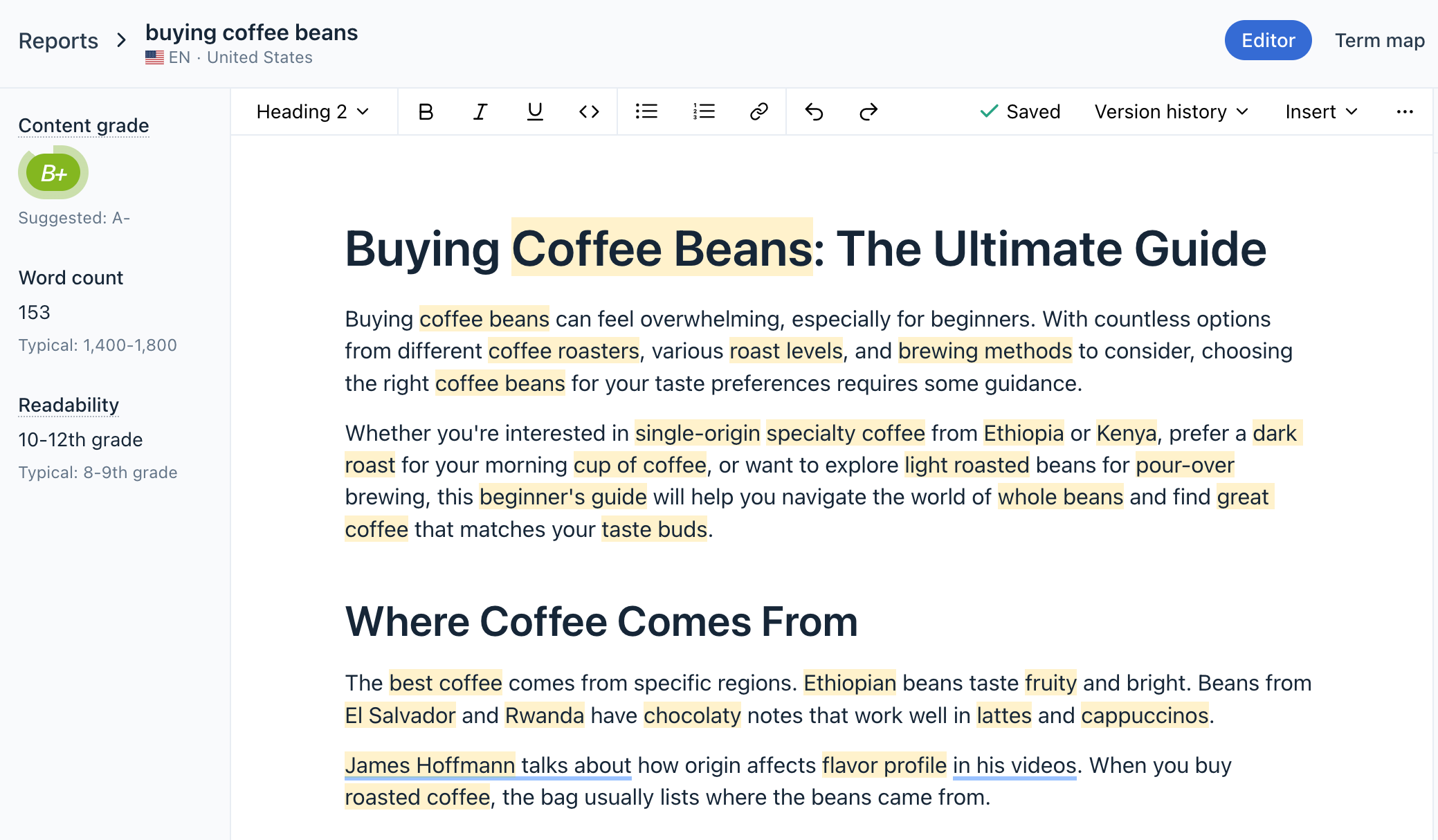
The grading system shows you what you're missing. Write for your readers first, but the grade keeps you from forgetting important topics. You can see what needs work before you hit publish.
Content inventory
One feature that really impressed me was the content inventory system. This shows you how all your existing articles are doing in Google search.
I connected my Google Search Console account and could see data about every piece of content on my site. It showed me which articles were getting clicks, where they ranked, and what that traffic would cost if I had to pay for it with Google Ads.
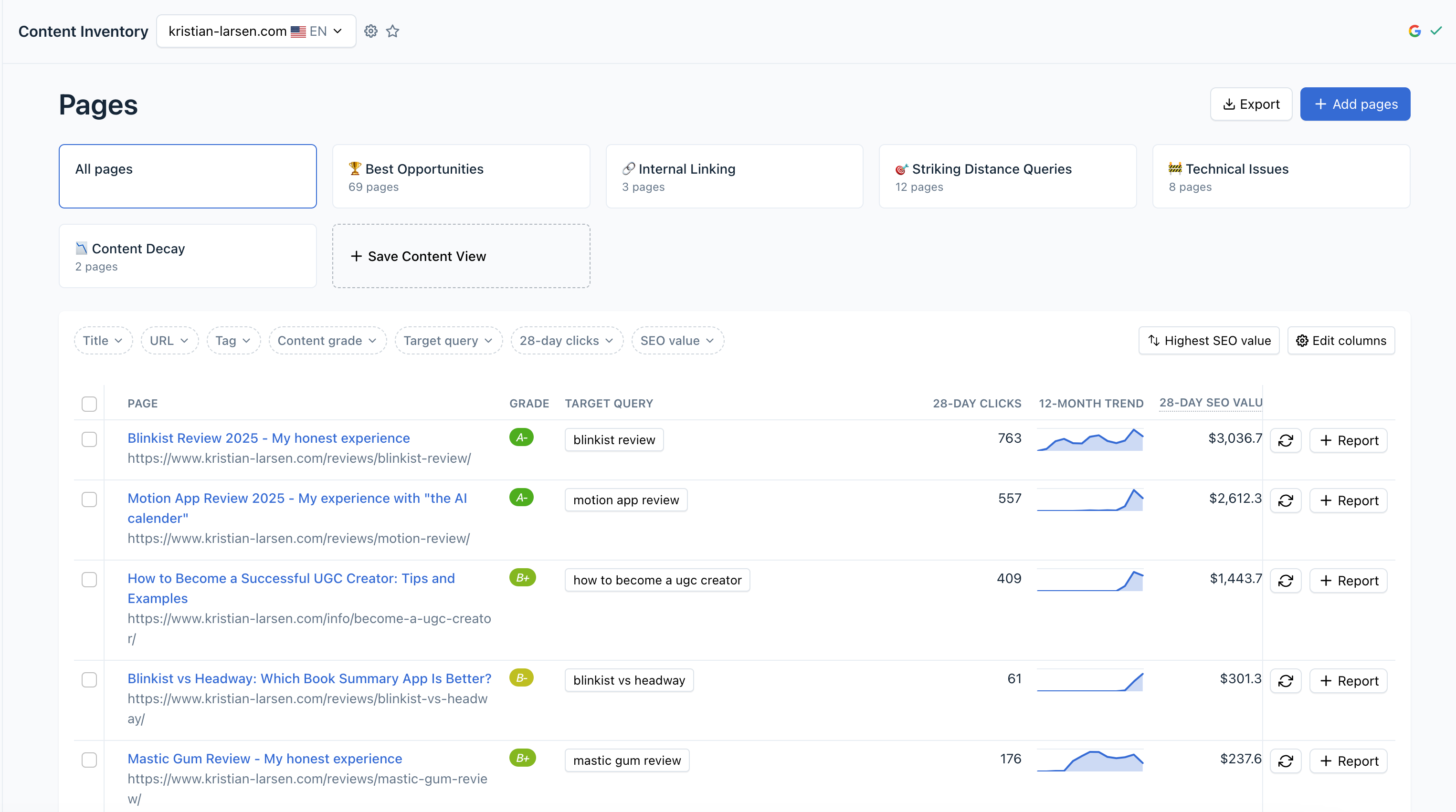
The most helpful part was seeing which of my content inventory pages were rising in search results. These were articles that could potentially rank better with some optimization. It also flagged technical problems and suggested where I could add links between articles.

Clearscope also put a dollar value on my traffic. It calculated what I'd have to pay in Google Ads to get the same amount of visitors I was getting organically. This helped me figure out which pages were worth updating based on their SEO value and current performance.
Google Docs Integration
I kept hearing that Clearscope's Google Docs integration was a game-changer. Since I write everything in Google Docs anyway, this seemed worth testing.
The setup was simple. You install a browser extension, connect it to your Clearscope account, and link any content report to your Google Doc. That's it.
When you start writing, a sidebar appears with your keyword recommendations and content grade. From there, just write normally, and you'll see Clearscope working just like it does when you use its dedicated web app.
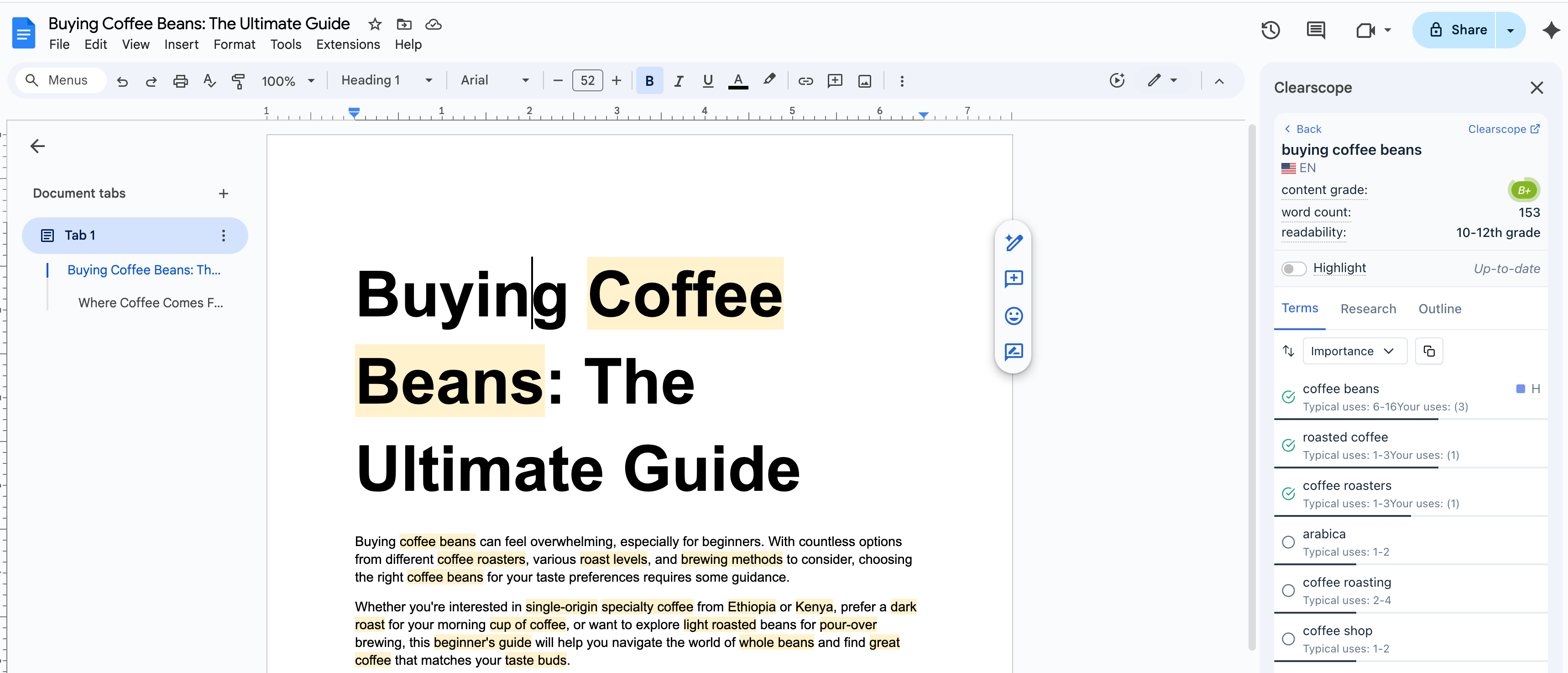
Most content marketers I know live in Google Docs. We share drafts, collaborate with team members, and handle revisions all in one place. Having optimization suggestions right there eliminates the friction that kills productivity.
AI Features
Nearly every content optimization platform powered by AI is adding automated writing tools, and Clearscope is no different.
The company has been rolling out AI features that promise to generate complete drafts and automate content strategy. I tested a few to see if they deliver on the hype.
Draft with AI
Draft with AI is a feature that appears after you create a regular Clearscope content optimization report. Instead of manually writing your article based on the optimization suggestions I covered earlier, you can click "Draft with AI" to have it generate a complete first draft using those same recommendations.
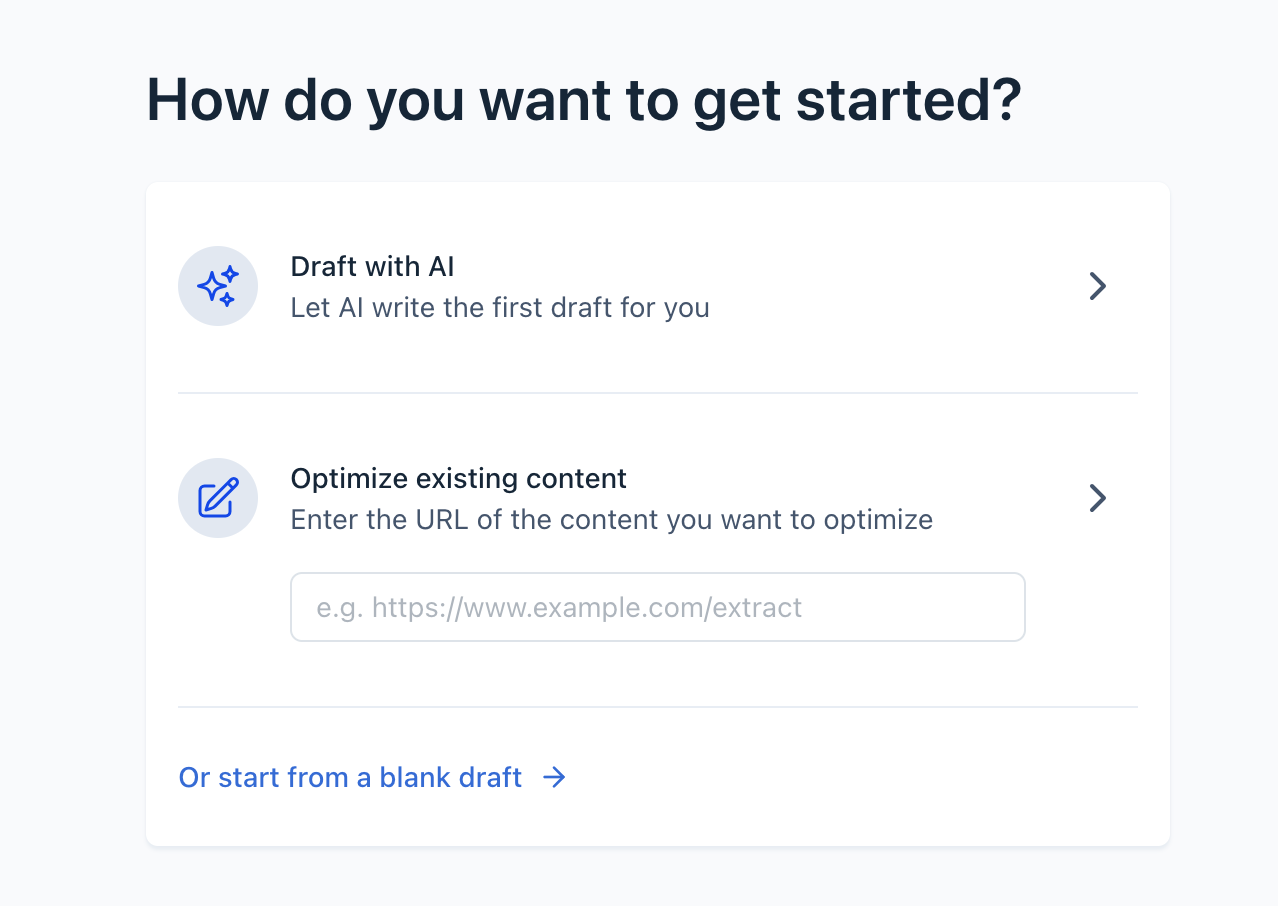
The tool walks you through six steps before generating any content. First, you select search intent from grouped categories. Clearscope had analyzed the top 10 search engine results pages and sorted them into intent types like "buying guides" versus "educational content."
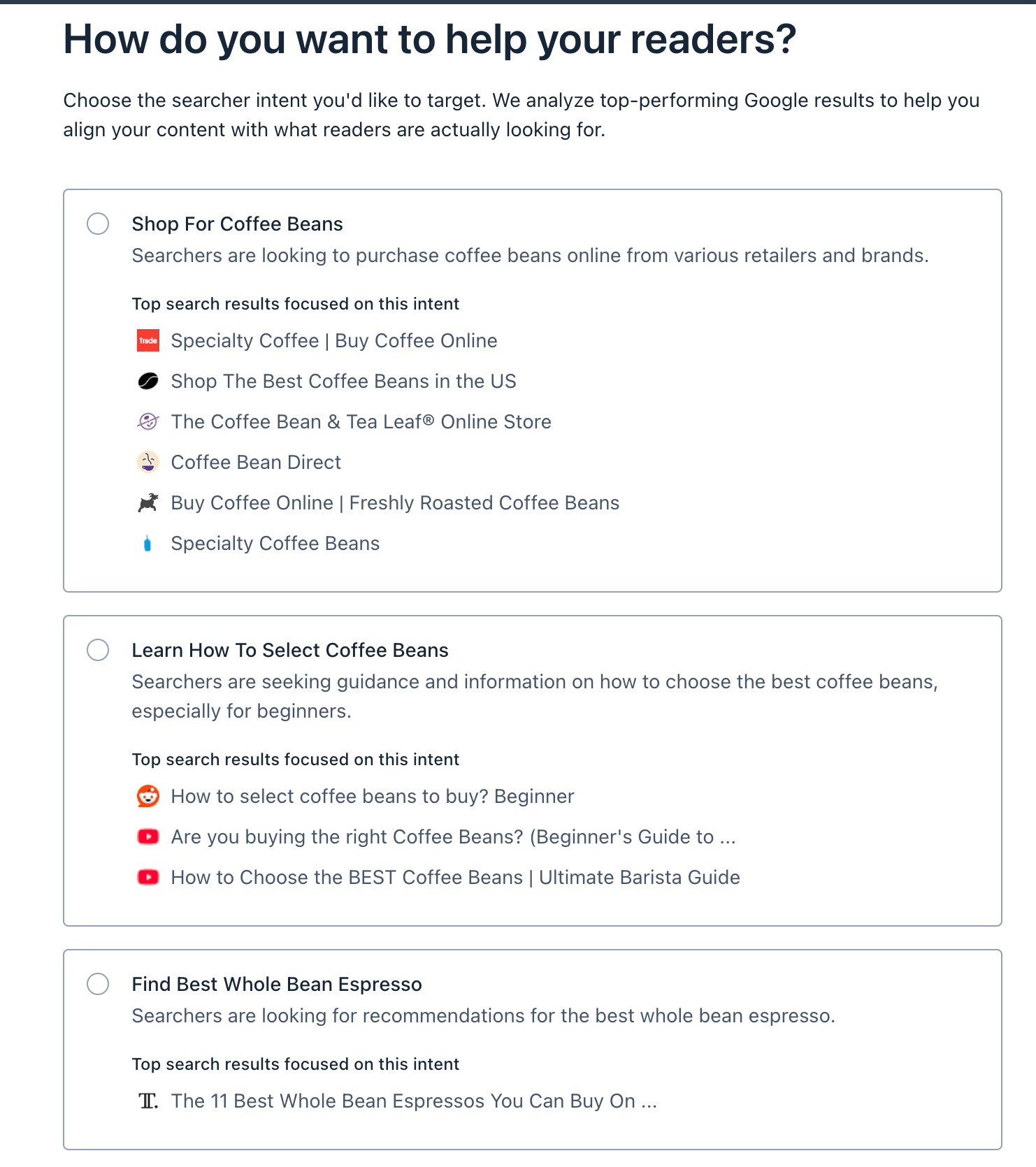
Then, you pick a content format, such as a how-to guide, research-driven post, or product highlight. If you have an existing high-performing article, Clearscope can also copy that structure and format.
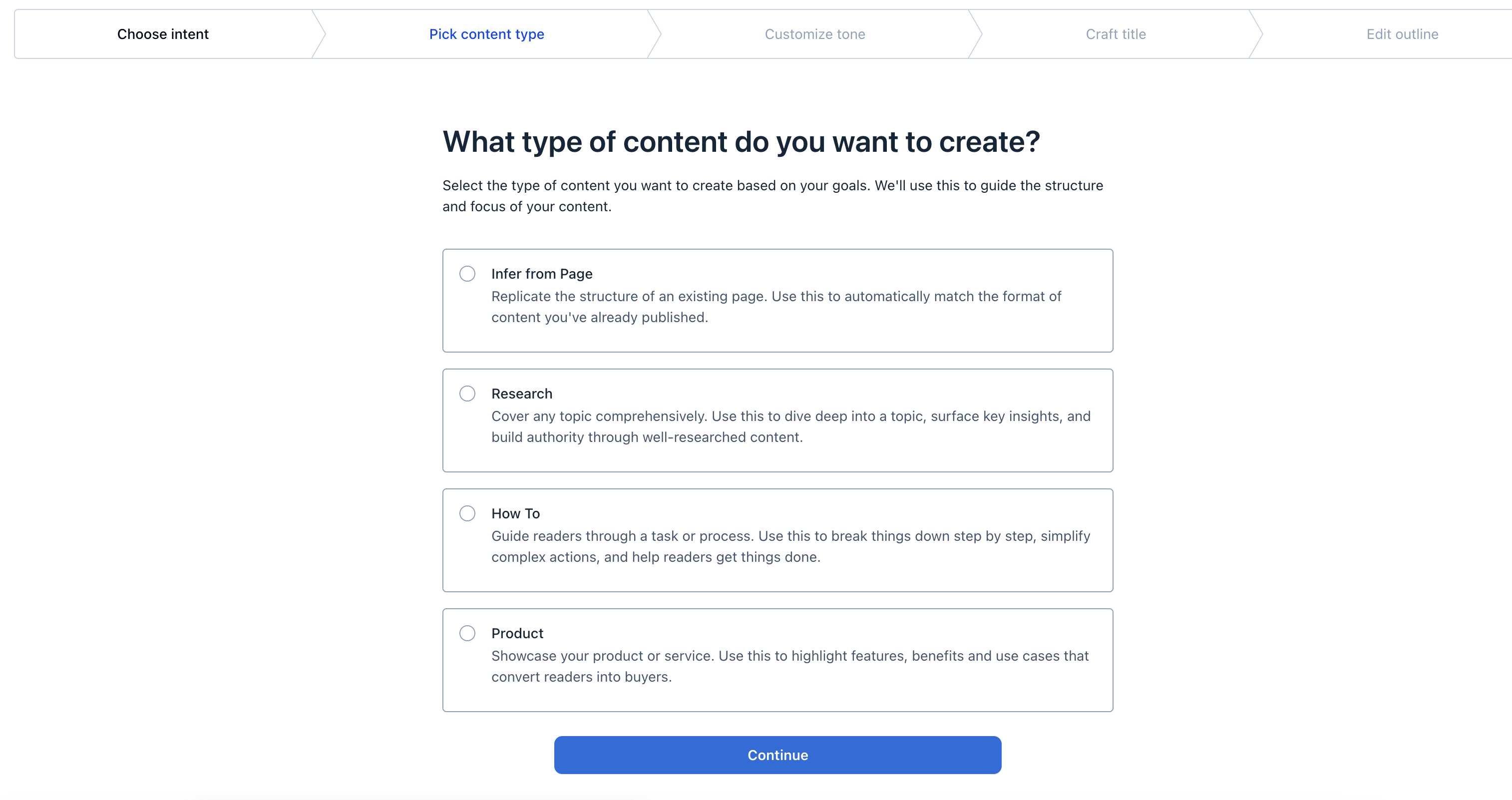
Next comes tone selection, where you can paste in writing samples so the AI matches your voice, or choose from preset options like professional or conversational. I uploaded an existing article from my blog for Clearscope to grasp my writing style.
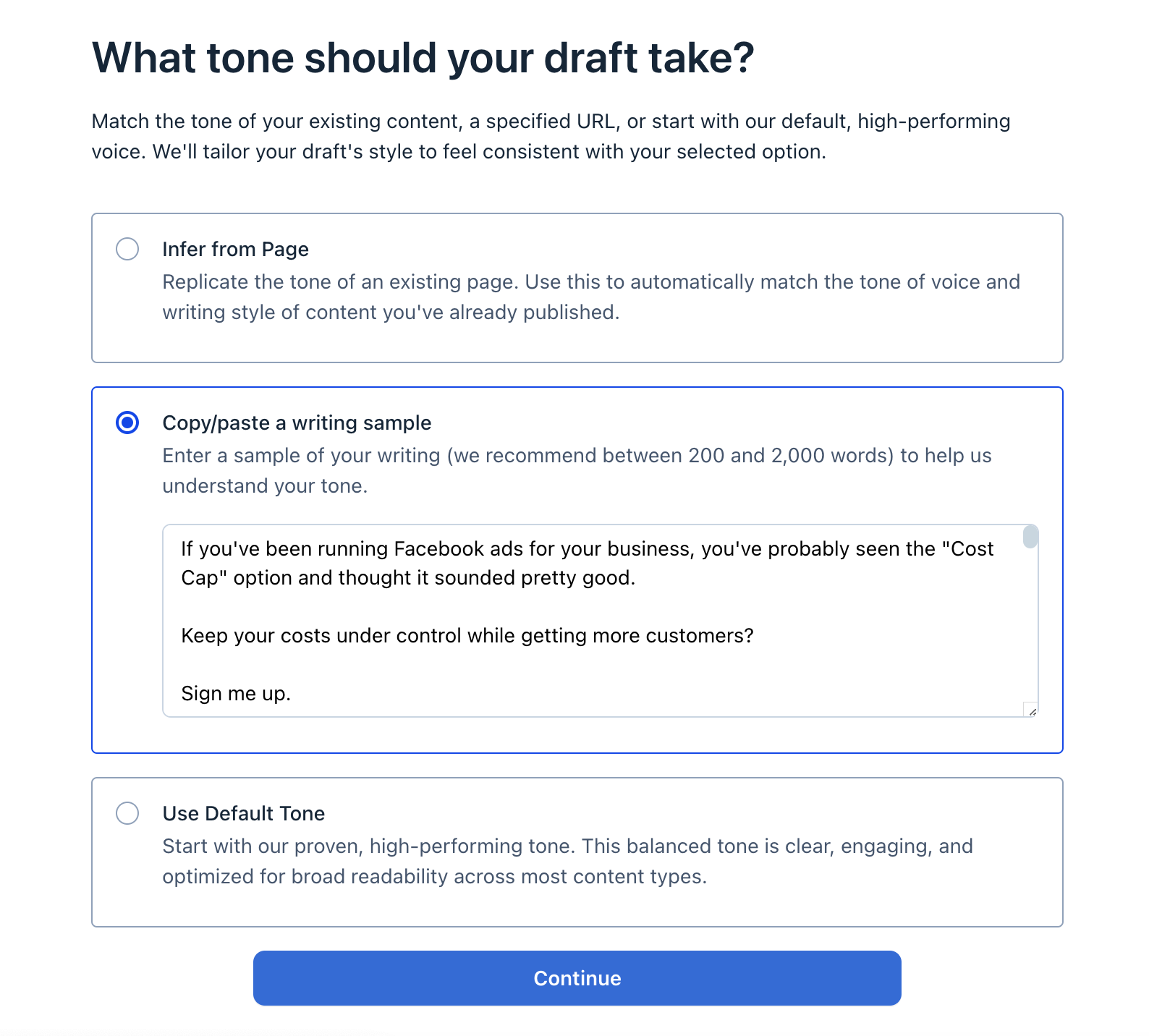
After that, Clearscope generates a few titles reflecting your article's purpose and the searcher's goal. I went with the one that included my target keyword so that Google could easily understand the term I am optimizing for.
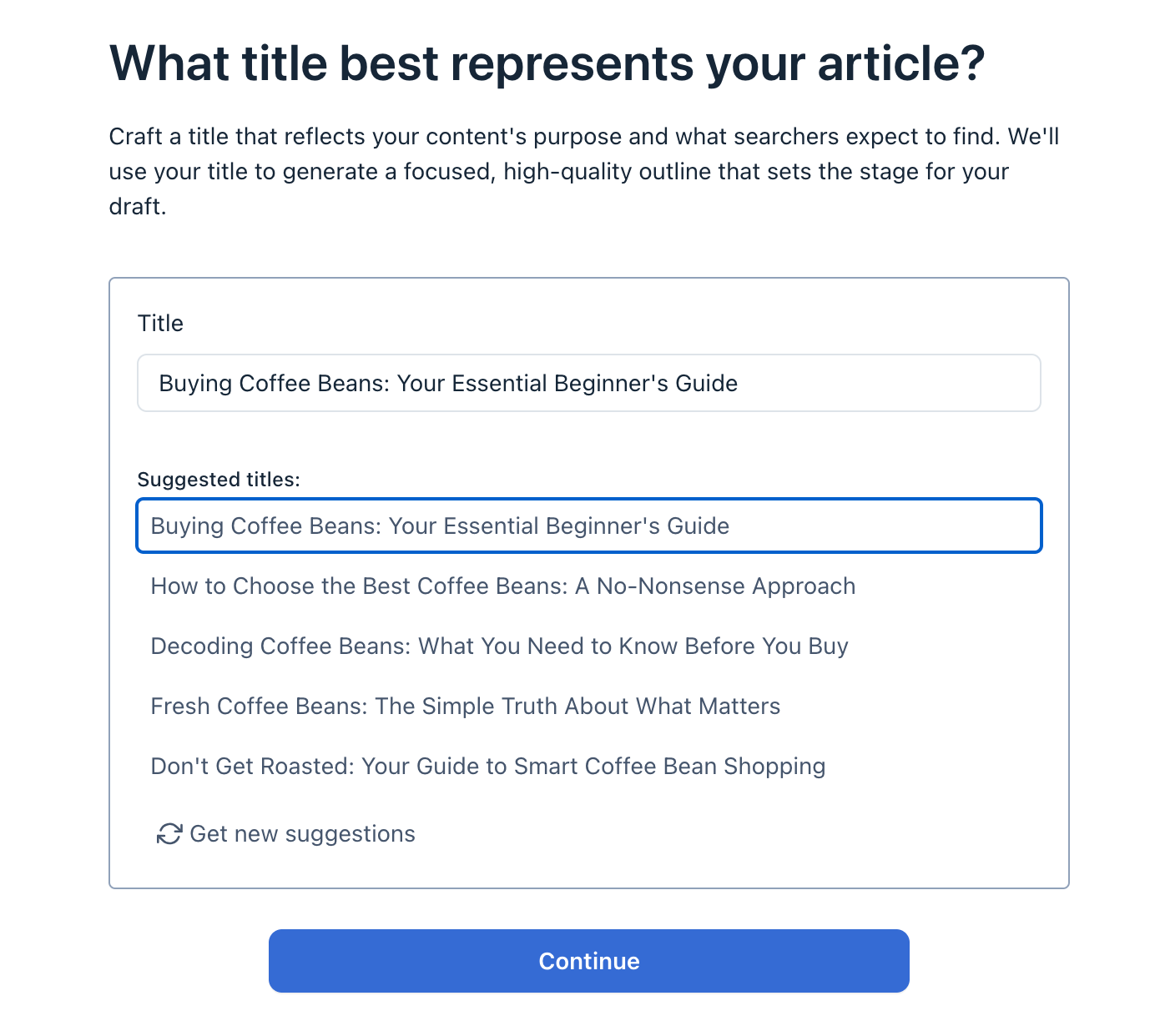
You also get a high-quality outline that you can edit before any content creation happens. The drag and drop functionality makes it easy to move sections around, plus you get the option to edit all H2 and H3 headings before moving on to the final step.
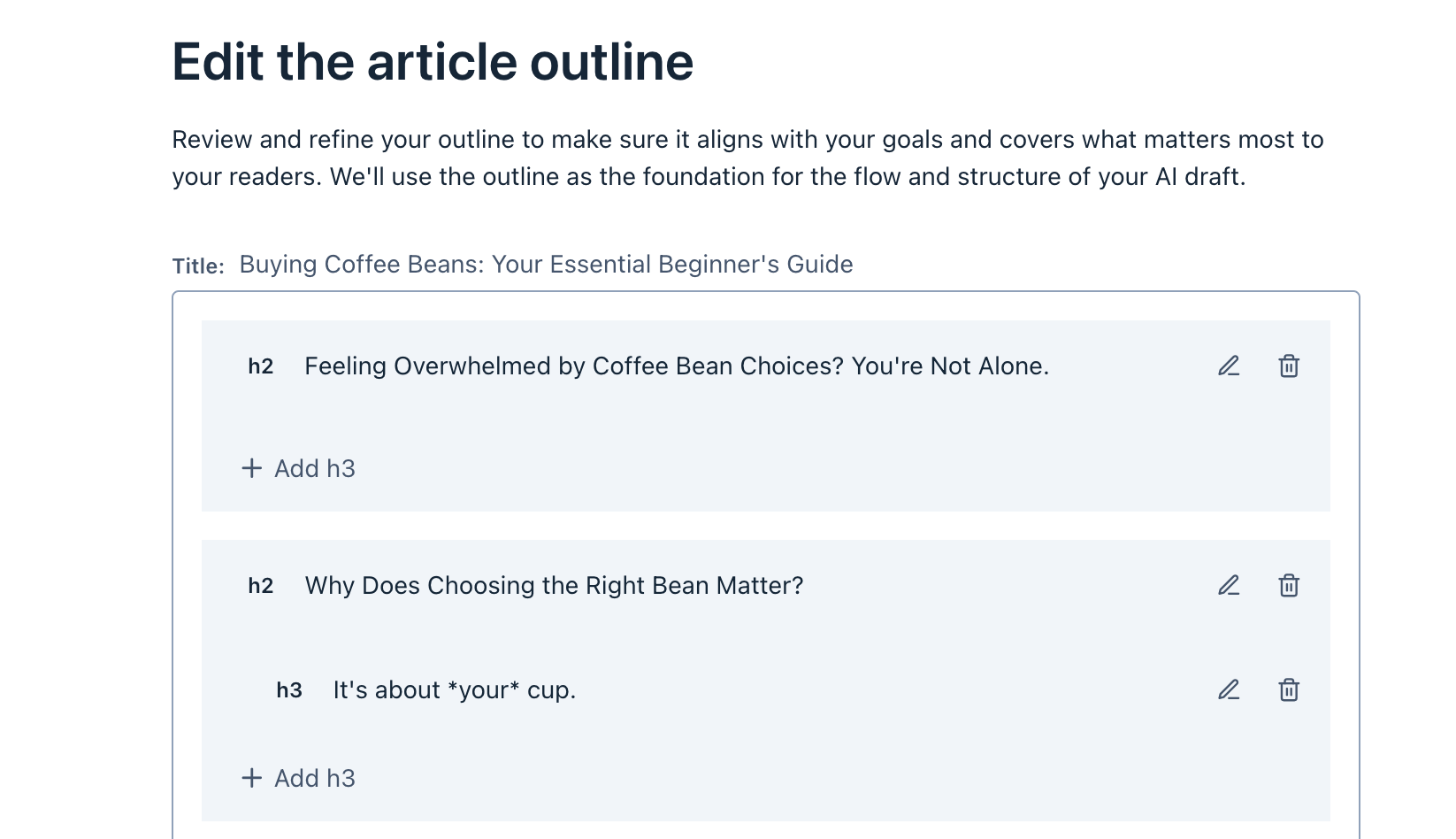
Clearscope then created a draft that looked quite decent. The AI picked up on patterns such as my sentence structure and paragraph breaks pretty well. The draft gave me a solid foundation that would have taken hours to research and outline manually.
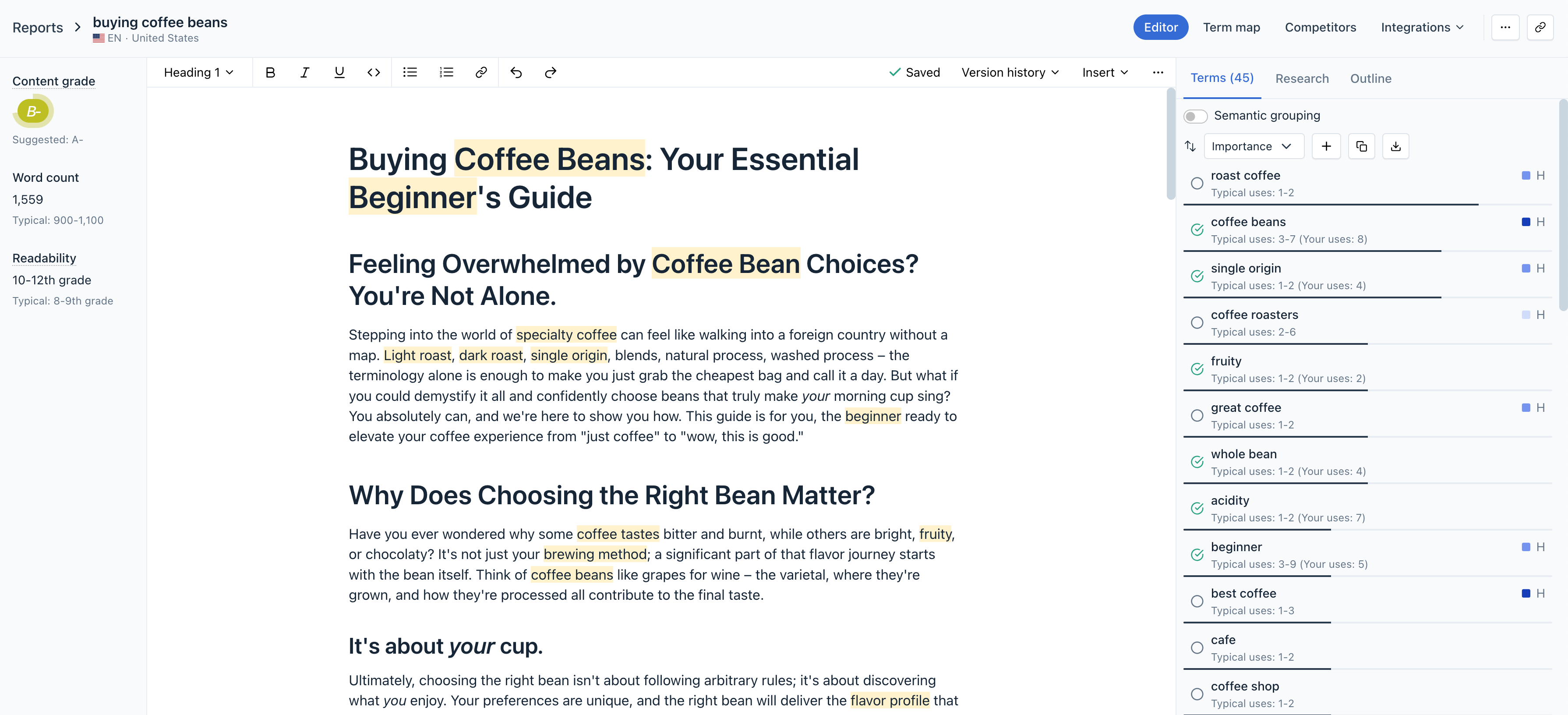
I spent about 30 minutes adding my own insights and personal experiences to make the content more unique. The AI handled the heavy lifting of structure and comprehensive topic coverage, so I could focus on adding value rather than wondering what to write about.
The Draft with AI feature basically gives you a head start on well-optimized content. You get a complete article that covers search intent and includes the right keywords, then you can make it your own with your expertise and perspective.
Topic Exploration
Topic Exploration is Clearscope's other AI feature that automates competitor research. You enter a keyword and it crawls Google to organize related keywords into visual clusters.
I tested it with "coffee beans" and got 5 topic clusters with 71 total keywords. The biggest cluster was "Coffee Beans (Local/Fresh)" with 87,420 monthly searches, followed by "Green Coffee Beans" at 66,940 searches.
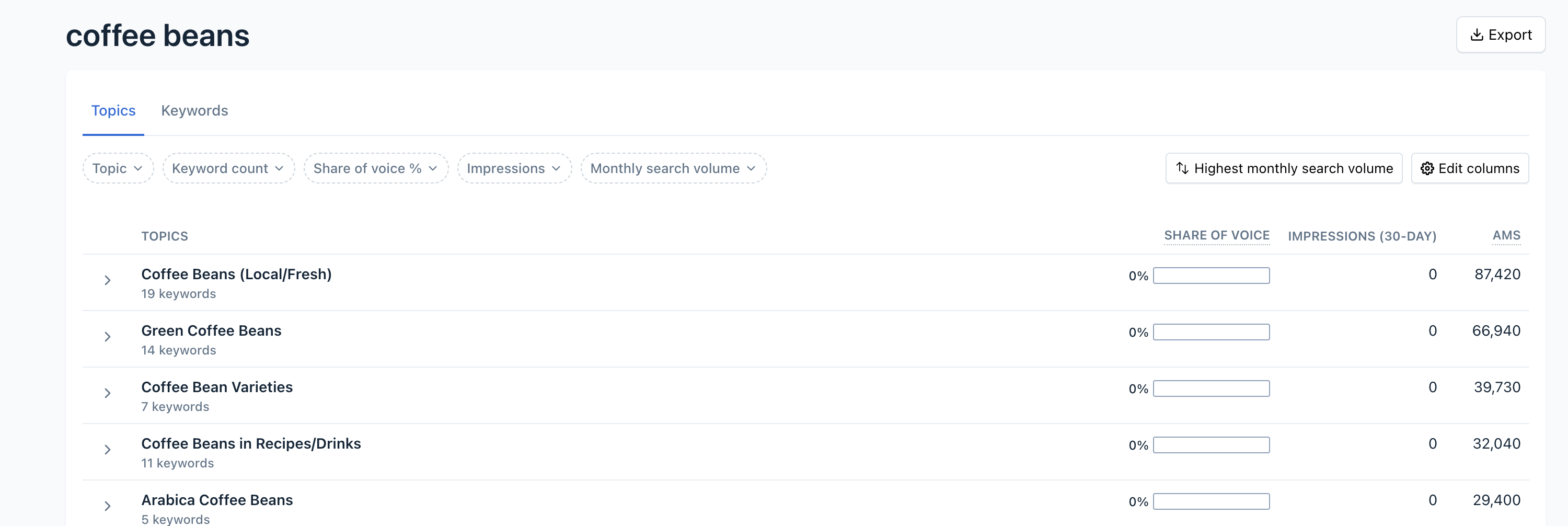
Each cluster shows specific keywords you can target to build coverage in that topic area. I could see terms like "coffee beans near me" (74,000 searches) and "green coffee beans" (40,500 searches), each with trend lines showing search patterns over time.
The interface let me filter by search volume and drill down into specific keywords. Everything was organized into logical groups I could actually prioritize.
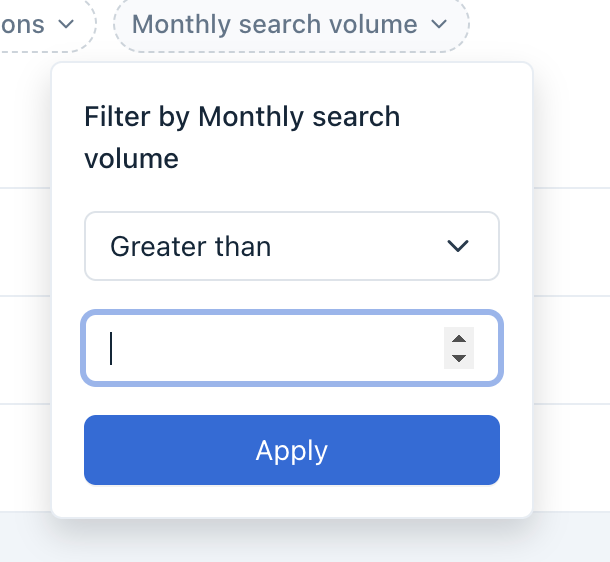
Compare that to manual research, where I'd spend hours opening competitor pages and taking notes. Topic Exploration gave me the same insights in minutes with clean visual data.
LLM Traffic
Clearscope is also working on a feature called "large language model traffic" that would track how your content performs in AI search engines like ChatGPT and Perplexity. The idea is to help you optimize for conversational AI search, not just traditional Google results.
This feature wasn't available when I tested Clearscope, so I can't say how well it works. But it shows the company is thinking about how search is going to evolve in the next few years.
Time and results
Setting up my first Clearscope report took about 20 minutes. The tool analyzed top-ranking pages, grouped keywords by intent, and gave me a clear roadmap for my coffee beans guide.
Compare that to my old manual process: spending hours checking competitor articles, guessing which topics mattered, and hoping I covered everything important. With Clearscope, I knew exactly what to write about from the start.
The optimization happened while I wrote. Real-time suggestions in Google Docs meant I could adjust keywords and add missing sections without switching between tools. No more finishing an article and wondering if it would rank.
My coffee buying guide hit position 6 within two months. Previous articles took four to six months to reach similar rankings. The time I spent optimizing paid off with faster results and better performance.
The daily updates save the most time. Clearscope tells me which existing articles need attention instead of me manually checking hundreds of posts. I can update three articles in the time it used to take me to research one new piece.
When you factor in faster ranking times and the ability to improve existing content efficiently, Clearscope justifies its price tag.
Clearscope Pricing vs Competitors
Clearscope costs $129 per month, which might seem steep at first glance. But when you compare it properly to similar tools, the value becomes clear.
Readers of my blog can now get a special Clearscope discount:
- Essential plan: $99/month (regularly $129)
- Business plan: $299/month (regularly $399)
Both discounts are valid for 6 full months.
The base plan gets you 20 content reports, unlimited content inventory pages, Google Docs integration, and access to all the AI features I tested. You can add as many team members as you want, which is nice if multiple people work on SEO content.
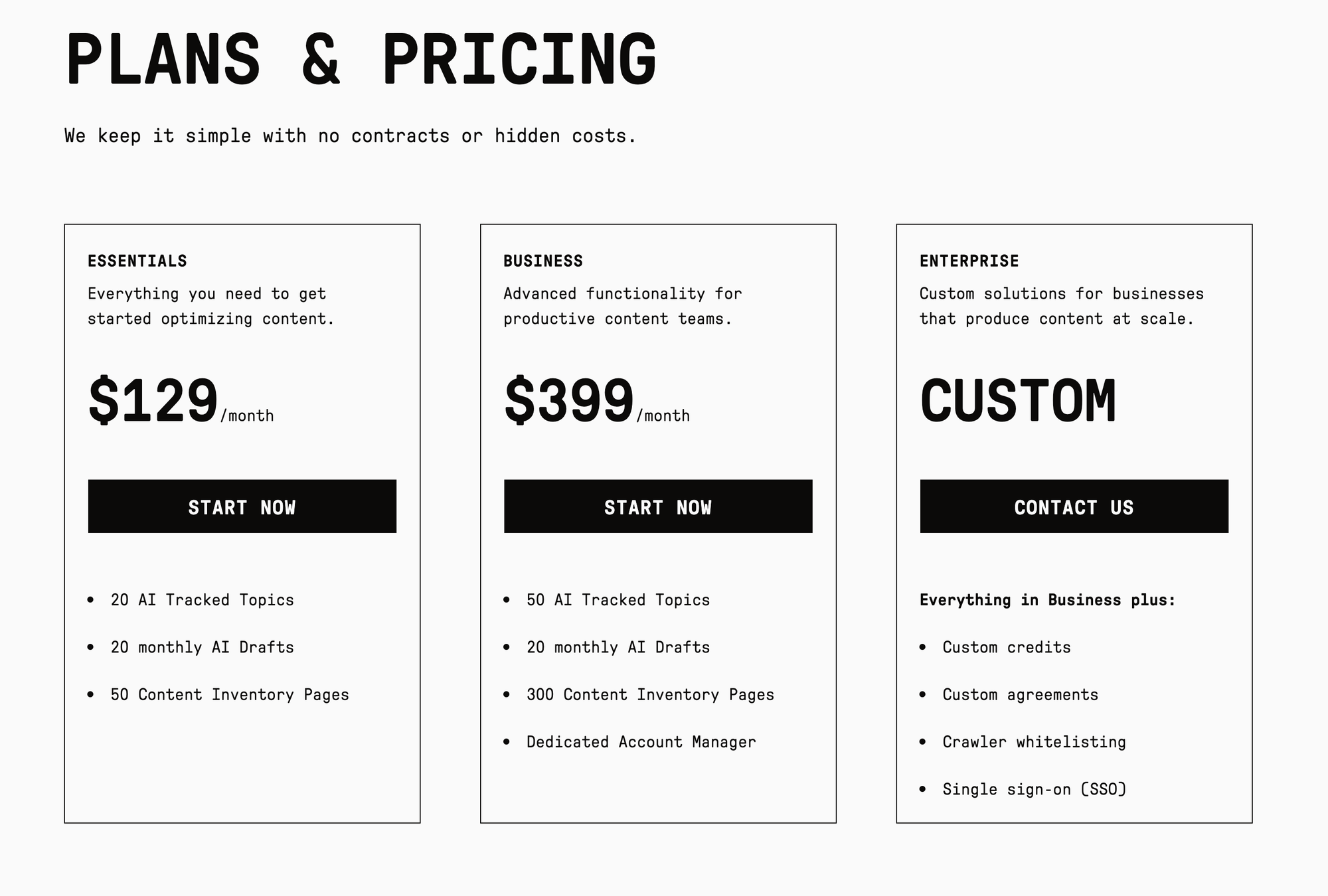
How Clearscope Stacks Up
When you compare apples to apples, Clearscope's pricing is actually competitive. Surfer SEO's Scale plan costs $219 monthly, which is $90 more than Clearscope's $129 base plan. Both include 20 AI articles, but Clearscope offers additional articles for as low as $2 each versus Surfer's $15 per additional article.
Although Surfer costs less to begin with at $99 per month, that's their Essential plan with only 5 AI articles and basic features. You'd need to upgrade to their $219 Scale plan to match what Clearscope offers in their base package.
Frase starts at $45 monthly, but you're missing the advanced AI features, content inventory tracking, and Google Docs integration that make Clearscope worth using.
Why It's Actually Smart Money
Clearscope replaces about four different tools you'd probably end up buying anyway.
- AI writing software like Jasper or Copy.ai gets replaced by Clearscope's Draft with AI feature
- Content optimization tools like Surfer SEO get replaced by the Content Editor
- Site monitoring tools like Screaming Frog or ContentKing get replaced by Content Inventory
- Keyword research and clustering tools like Keyword Insights get replaced by Topic Exploration
Add those subscriptions up and you're already past $129. Plus, you avoid constantly logging into different platforms, copying data back and forth, and generally wanting to throw your laptop out the window.
Clearscope Pros and Cons
After spending quite a bit of time with Clearscope, I have a good sense of the strengths and weaknesses of this tool.
What Clearscope Does Well
- Easy to learn: Clearscope's user interface makes it easy to get started. If you understand basic on page SEO and search volume concepts, you'll be optimizing content within minutes without needing training videos or tutorials.
- Shows you the ROI in dollars: It calculates what your organic traffic would cost through Google Ads. When someone questions your budget, you can say "this saved us $12,000 in ad spend last quarter" and suddenly everyone gets it.
- AI tool gives you a head start: Their artificial intelligence handles the research and gives you content ideas for your target audience. You still need to edit for context, but it saves you from staring at a blank page.
- WordPress plugin saves tons of time: You can embed your Clearscope reports directly into WordPress. Just paste the shared link and see your content grade, word count, and keyword suggestions right in the editor. That's way better than switching between tabs or using Microsoft Word.
- Best content optimization tool for focus: Instead of trying to do backlink analysis and local SEO like other tools, they just focus on making your SEO content perform better in search engine results pages. Sometimes that's exactly what you need.
Where It Falls Short
- Clearscope's customer support is slow: Email-only support on a tool this expensive feels wrong. When you're stuck on a deadline, waiting 24+ hours for responses sucks.
- Learning curve for beginners: This content creation platform assumes you know SEO basics. If you don't understand relevant keywords, keyword usage, or search results fundamentals, you'll struggle.
That's a Wrap
If you've been searching for an honest Clearscope review, this should give you what you need to make a decision. I've tested everything from the user friendly interface to those painful pricing plans, covering all the Clearscope features that matter for SEO professionals and content marketers.
Here's my take: Clearscope is a serious competitor to many SEO tools.
I've replaced SurferSEO and a series of other tools in favor for it.
One last thing: content optimization works when your writing is good to start with. It won't make bad content suddenly great. So focus on creating relevant content for your audience first, then worry about optimization tools like this one.


